Evaluation of Feature Extraction and Recognition for Activity Monitoring and Fall Detection Based on Wearable sEMG Sensors
Abstract
:1. Introduction
2. Activity Monitoring and Data Acquisition
3. Algorithm Description
3.1. Feature Extraction
3.2. Feature Class Separability
3.3. Classification
4. Experiments and Results
4.1. Class Separability Results
4.2. Activities Recognition Results
4.3. Fall Detection Results
5. Discussion
6. Conclusions
Acknowledgments
Author Contributions
Conflicts of Interest
References
- Leone, A.; Rescio, G.; Caroppo, A.; Siciliano, P. An EMG-based system for pre-impact fall detection. In Proceedings of the IEEE Sensors 2015, Busan, Korea, 1–4 November 2015; pp. 1–4. [Google Scholar]
- Tobon, D.P.; Falk, T.; Maier, M. Context awareness in WBANs: A survey on medical and non-medical applications. IEEE Wirel. Commun. 2013, 20, 30–37. [Google Scholar] [CrossRef]
- Roy, S.H.; Cheng, M.S.; Chang, S.S.; Moore, J.; Luca, G.D.; Nawab, S.H.; De Luca, C.J. A combined sEMG and accelerometer system for monitoring functional activity in stroke. IEEE Trans. Neural Syst. Rehabil. Eng. 2009, 17, 585–594. [Google Scholar] [CrossRef] [PubMed]
- Cheng, J.; Chen, X.; Shen, M. A framework for daily activity monitoring and fall detection based on surface electromyography and accelerometer signals. IEEE. J. Biomed. Health Inform. 2013, 17, 38–45. [Google Scholar] [CrossRef] [PubMed]
- Hijaz, F.; Afzal, N.; Ahmad, T.; Hasan, O. Survey of fall detection and daily activity monitoring techniques. In Proceedings of the 2010 International Conference on Information and Emerging Technologies, Karachi, Pakistan, 14–16 June 2010; pp. 1–6. [Google Scholar]
- Le, C.H.; Lee, R.; Luo, J.; Phan, P.A.; Le, T.; Le, M.H. Assistive technologies for the older people: Physical activity monitoring and fall detection. In Proceedings of the 6th International Conference on the Development of Biomedical Engineering in Vietnam (BME6), Ho Chi Ming City, Vietnam, 27–29 June 2016; Volume 20, pp. 102–105. [Google Scholar]
- González-Villanueva, L.; Cagnoni, S.; Ascari, L. Design of a wearable sensing system for human motion monitoring in physical rehabilitation. Sensors 2013, 13, 7735–7755. [Google Scholar] [CrossRef] [PubMed]
- Zhu, C.; Sheng, W.H. Wearable sensor-based hand gesture and daily activity recognition for robot-assisted living. IEEE Trans. Syst. Man Cybern. Part A Syst. Hum. 2011, 41, 569–573. [Google Scholar] [CrossRef]
- Wu, G.; Xue, S.W. Portable preimpact fall detector with inertial sensors. IEEE Trans. Neural Syst. Rehabil. Eng. 2008, 16, 178–183. [Google Scholar] [PubMed]
- Ghasemzadeh, H.; Jafari, R.; Prabhakaran, B. A body sensor network with electromyogram and inertial sensors: Multimodal interpretation of muscular activities. IEEE Trans. Inf. Technol. Biomed. 2010, 14, 198–206. [Google Scholar] [CrossRef] [PubMed]
- Mukhopadhyay, S.C. Wearable sensors for human activity monitoring: A review. IEEE Sens. J. 2015, 15, 1321–1330. [Google Scholar] [CrossRef]
- Fortino, G.; Gravina, R. Fall-MobileGuard: A Smart Real-Time Fall Detection System. In Proceedings of the 10th International Conference on Body Area Networks (BodyNets 2015), Sydney, Australia, 28–30 September 2015. [Google Scholar]
- Chen, K.H.; Yang, J.J.; Jaw, F.S. Accelerometer-based fall detection using feature extraction and support vector machine algorithms. Instrum. Sci. Technol. 2016, 44, 333–342. [Google Scholar] [CrossRef]
- Rescio, G.; Leone, A.; Siciliano, P. Support Vector Machine for tri-axial accelerometer-based fall detector. In Proceedings of the IEEE International Workshop on Advances in Sensors & Interfaces, Bari, Italy, 13–14 June 2013; pp. 25–30. [Google Scholar]
- Nii, M.; Iwamoto, T.; Ishibashi, Y.; Komori, D. Improvement of Fuzzy Neural Network Based Human Activity Estimation System. In Proceedings of the IEEE International Conference on Systems, Kowloon, China, 9–12 October 2015; pp. 2310–2315. [Google Scholar]
- Shi, G.; Chan, C.S. Mobile Human Airbag System for Fall Protection Using MEMS Sensors and Embedded SVM Classifier. IEEE Sens. J. 2009, 9, 495–503. [Google Scholar] [CrossRef]
- Nyan, M.N.; Tay, F.E.; Tan, A.K. Distinguishing fall activities from normal activities by angular rate characteristics and high-speed camera characterization. Med. Eng. Phys. 2006, 28, 842–849. [Google Scholar] [CrossRef] [PubMed]
- Ramachandran, R.; Ramanna, L.; Ghasemzadeh, H.; Pradhan, G.; Jafari, R.; Prabhakaran, B. Body Sensor Networks to Evaluate Standing Balance: Interpreting Muscular Activities Based on Inertial Sensors. In Proceedings of the 2nd International Workshop on Systems and Networking Support for Health Care and Assisted Living Environments, Breckenridge, CO, USA, 17 June 2008. [Google Scholar]
- Basmajian, J.V. Muscles Alive: Their Functions Revealed by Electromyography, 2nd ed.; Williams and Wilkins: Baltimore, MD, USA, 1967; p. 421. [Google Scholar]
- Adewuyi, A.A.; Hargrove, L.J.; Kuiken, T.A. An analysis of intrinsic and extrinsic hand muscle EMG for improved pattern recognition control. IEEE Trans. Neural Syst. Rehabil. Eng. 2016, 24, 485–494. [Google Scholar] [CrossRef] [PubMed]
- Kempen, J.C.; Doorenbosch, C.A.; Knol, D.L.; de Groot, V.; Beckerman, H. Newly identified gait patterns in patient with multiple sclerosis may be related to push-off quality. Phys. Ther. 2016, 96, 1744–1752. [Google Scholar] [CrossRef] [PubMed]
- Vujaklija, I.; Farina, D.; Aszmann, O. New developments in prosthetic arm systems. Orthop. Res. Rev. 2016, 8, 31–39. [Google Scholar] [CrossRef]
- Cheng, M.S. Monitoring Functional Motor Activities in Patients with Stroke. Ph.D. Thesis, Boston University, Boston, MA, USA, 2005. [Google Scholar]
- Uchida, N.; Hiraiwa, A.; Sonehara, N.; Shimohara, K. EMG Pattern Recognition by Neural Networks for Multi Fingers Control. In Proceedings of the 14th Annual International Conference of the IEEE Engineering in Medicine and Biology Society, Paris, France, 29 October–1 November 1992; pp. 1016–1018. [Google Scholar]
- Park, S.H.; Lee, S.P. EMG Pattern Recognition Based on Artificial Intelligence Techniques. IEEE Trans. Rehabil. Eng. 1998, 6, 400–405. [Google Scholar] [CrossRef] [PubMed]
- Matsumura, Y.; Fukumi, M.; Mitsukura, Y.; Akamatsu, N. Recognition system of EMG patterns by neural networks. In Proceedings of the 41st SICE Annual Conference, Singapore, 18–22 November 2002; pp. 1613–1617. [Google Scholar]
- Wang, Q.; Chen, Y. A Novel Pedestrian Dead Reckoning Solution Using Motion Recognition Algorithm with Wearable EMG Sensors. Int. J. Sens. Netw. Data Commun. 2011, 3, 115. [Google Scholar] [CrossRef]
- Myers, A.; Du, L.; Huang, H.; Zhu, Y. Novel wearable EMG sensors based on nanowire technology. In Proceedings of the 36th Annual International Conference of the IEEE Engineering in Medicine and Biology Society, Chicago, IL, USA, 26–30 August 2014; pp. 1674–1677. [Google Scholar]
- Yang, B.S.; Liao, S.T. Fall Detecting Using Inertial and Electromyographic Sensors. In Proceedings of the 36th Annual Meeting of the American Society of Biomechanics, Gainsville, FL, USA, 15–18 August 2012. [Google Scholar]
- Sakai, M.; Shiba, Y.; Sato, M.; Takahira, N. Motor Adaptation during Slip-Perturbed Gait in Older Adults. J. Phys. Ther. Sci. 2008, 20, 109–115. [Google Scholar] [CrossRef]
- Lee, J.K.; Robinovitch, S.N.; Park, E.J. Inertial Sensing-Based Pre-Impact Detection of Falls Involving Near-Fall Scenarios. IEEE Trans. Neural Syst. Rehabil. Eng. 2015, 23, 258–266. [Google Scholar] [CrossRef] [PubMed]
- Leone, A.; Rescio, G.; Caroppo, A.; Siciliano, P. A Wearable EMG-based System Pre-fall Detector. Procedia Eng. 2015, 120, 455–458. [Google Scholar] [CrossRef]
- Arief, Z.; Sulistijono, I.A.; Ardiansyah, R.A. Comparison of five time series EMG features extractions using Myo Armband. In Proceedings of the 2015 International Electronics Symposium (IES), Surabaya, Indonesia, 29–30 September 2015; pp. 11–14. [Google Scholar]
- Phinyomark, A.; Limsakul, C.; Phukpattaranont, P. A novel feature extraction for robust EMG pattern recognition. J. Comput. 2009, 1, 71–80. [Google Scholar]
- Nurhazimah, N.; Mohd, A.A.R.; Shin-Ichiroh, Y.; Siti, A.A.; Hairi, Z.; Saiful, A.M. A Review of Classification Techniques of EMG Signals during Isotonic and Isometric Contractions. Sensors 2016, 16, 1304. [Google Scholar]
- Kakoty, N.M.; Saikia, A.; Hazarika, S.M. Exploring a family of wavelet transforms for EMG-based grasp recognition. Signal Imag. Video Process. 2015, 9, 553–559. [Google Scholar] [CrossRef]
- Song, Q.; Yu, Y.; Ge, Y.; Gao, Z.; Shen, H.; Deng, X. A real-time EMG-driven arm wrestling robot considering motion characteristics of human upper limbs. Int. J. Humanoid Robot. 2007, 4, 645–670. [Google Scholar] [CrossRef]
- Xing, K.; Yang, P.; Huang, J.; Wang, Y.; Zhu, Q. A real-time EMG pattern recognition method for virtual myoelectric hand control. Neurocomputing 2014, 136, 345–355. [Google Scholar] [CrossRef]
- Borowska, M. Entropy-based algorithms in the analysis of biomedical signals. Stud. Logic Gramm. Rhetor. 2015, 43, 21–32. [Google Scholar] [CrossRef]
- Diab, A.; Hassan, M.; Marque, C.; Karlsson, B. Performance analysis of four nonlinearity analysis methods using a model with variable complexity and application to uterine EMG signals. Med. Eng. Phys. 2014, 36, 761–767. [Google Scholar] [CrossRef] [PubMed]
- Zhang, Y.; Wu, L. Classification of Fruits Using Computer Vision and a Multiclass Support Vector Machine. Sensors 2012, 12, 12489–12505. [Google Scholar] [CrossRef] [PubMed]
- Davtalab, R.; Dezfoulian, M.H.; Mansoorizadeh, M. Multi-level fuzzy min-max neural network classifier. IEEE Trans. Neural Netw. Learn. Syst. 2014, 25, 470–482. [Google Scholar] [CrossRef] [PubMed]
- Ajiboye, A.B.; Weir, R.F. A heuristic fuzzy logic approach to EMG pattern recognition for multifunctional prosthesis control. IEEE Trans. Neural Syst. Rehabil. Eng. 2005, 13, 280–291. [Google Scholar] [CrossRef] [PubMed]
- Boostani, R.; Moradi, M.H. Evaluation of the forearm EMG signal features for the control of a prosthetic hand. Physiol. Meas. 2003, 24, 309–319. [Google Scholar] [CrossRef] [PubMed]
- Lee, S.W.; Yi, T.; Jung, J.W.; Bien, Z. Design of a Gait Phase Recognition System That Can Cope With EMG Electrode Location Variation. IEEE Trans. Autom. Sci. Eng. 2015. [Google Scholar] [CrossRef]
- Omuro, K.; Shiba, Y.; Obuchi, S.; Takahira, N. Effect of ankle weights on EMG activity of the semitendinosus and knee stability during walking by community-dwelling elderly. Rigakuryoho Kagaku 2011, 26, 55–59. [Google Scholar] [CrossRef]
- Lichtwark, G.A.; Bougoulias, K.; Wilson, A.M. Muscle fascicle and series elastic element length changes along the length of the human gastrocnemius during walking and running. J. Biomech. 2007, 40, 157–164. [Google Scholar] [CrossRef] [PubMed]
- Chang, G.C.; Kang, W.J.; Luh, J.J.; Cheng, C.K.; Lai, J.S.; Chen, J.J.J.; Kuo, T.S. Real-time implementation of electromyogram pattern recognition as a control command of man-machine interface. Med. Eng. Phys. 1996, 18, 529–537. [Google Scholar] [CrossRef]
- Zardoshti-Kermani, M.; Wheeler, B.C.; Badie, K.; Hashemi, R.M. EMG Feature Evaluation for Movement Control of Upper Extremity Prostheses. IEEE Trans. Rehabil. Eng. 1996, 3, 324–333. [Google Scholar] [CrossRef]
- Park, E.; Meek, S.G. Adaptive filtering of the electromyographic signal for prosthetic control and force estimation. IEEE Trans. Biomed. Eng. 1993, 40, 1048–1052. [Google Scholar] [CrossRef] [PubMed]
- Graupe, J.; Salahi, J.; Zhang, D. Stochastic analysis of myoelectric temporal signatures for multifunctional single-site activation of prostheses and orthoses. J. Biomed. Eng. 1985, 7, 18–28. [Google Scholar] [CrossRef]
- Aishwarya, R.; Prabhu, M.; Sumithra, G.; Anusiya, M. Feature extraction for EMG based prostheses control. ICTACT J. Soft Comput. 2013, 3, 472–477. [Google Scholar]
- Hornstein, E.; Shomron, N. Zero crossing of a wavelet transform. IEEE Trans. Inf. Theory 1991, 37, 1019–1033. [Google Scholar]
- Kosko, B. Fuzzy entropy and conditioning. Inf. Sci. 1986, 40, 165–174. [Google Scholar] [CrossRef]
- Olofsen, E.; Sleigh, J.W.; Dahan, A. Permutation entropy of the electroencephalogram: A measure of anaesthetic drug effect. Br. J. Anaesth. 2008, 101, 810–821. [Google Scholar] [CrossRef] [PubMed]
- Bandt, C.; Pompe, B. Permutation entropy: A natural complexity measure for time series. Phys. Rev. Lett. 2002, 88, 174102. [Google Scholar] [CrossRef] [PubMed]
- Webb, A.R. Statistical Pattern Recognition; John Weley & Sons: Chichester, UK, 2002. [Google Scholar]
- Mohammed, M.F.; Lim, C.P.; Quteishat, A. A novel trust measurement method based on certified belief in strength for a multi-agent classifier system. Neural Comput. Appl. 2014, 24, 421–429. [Google Scholar] [CrossRef]
- Seera, M.; Lim, C.P. Online motor fault detection and diagnosis using a hybrid FMM-CART model. IEEE Trans. Neural Netw. Learn. Syst. 2014, 25, 806–812. [Google Scholar] [CrossRef] [PubMed]
- Fauvel, M.; Bouveyron, C.; Girard, S. Parsimonious Gaussian process models for the classilcation of hyperspectral remote sensing images. IEEE Geosci. Remote Sens. Lett. 2015, 12, 2423–2427. [Google Scholar] [CrossRef]
- Karlik, B. Machine learning algorithms for characterization of EMG signals. Int. J. Inf. Electron. Eng. 2014, 4, 189–194. [Google Scholar] [CrossRef]


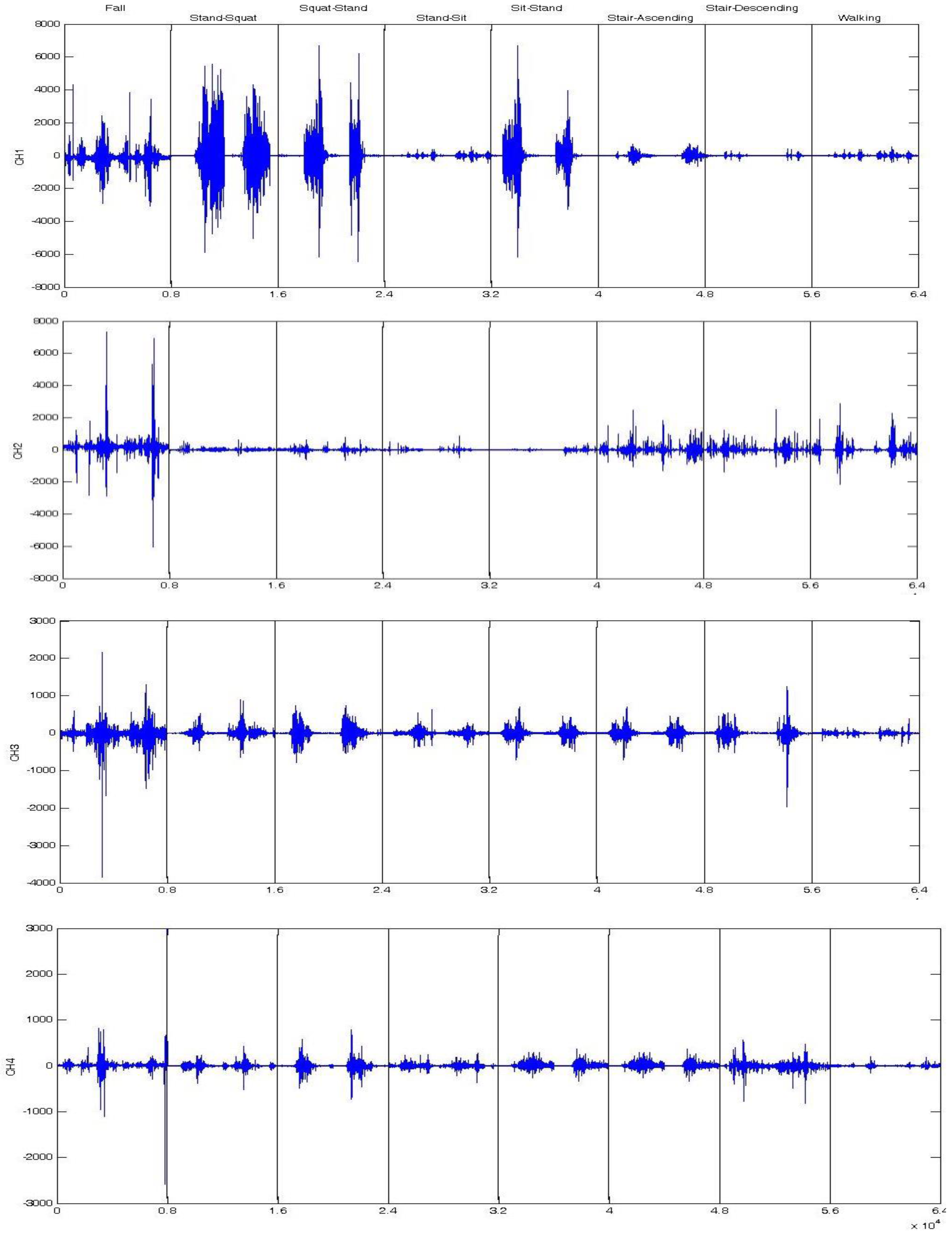
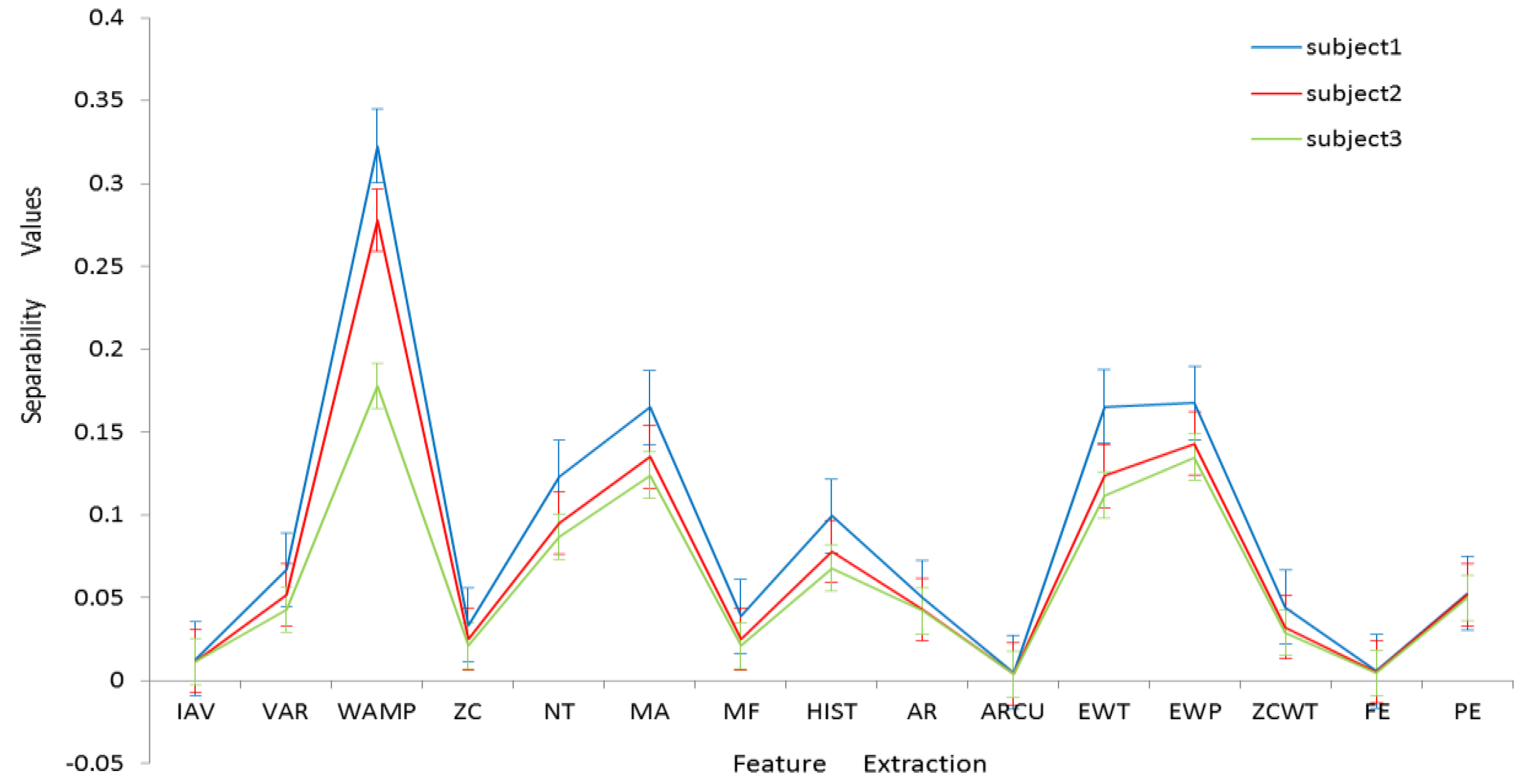
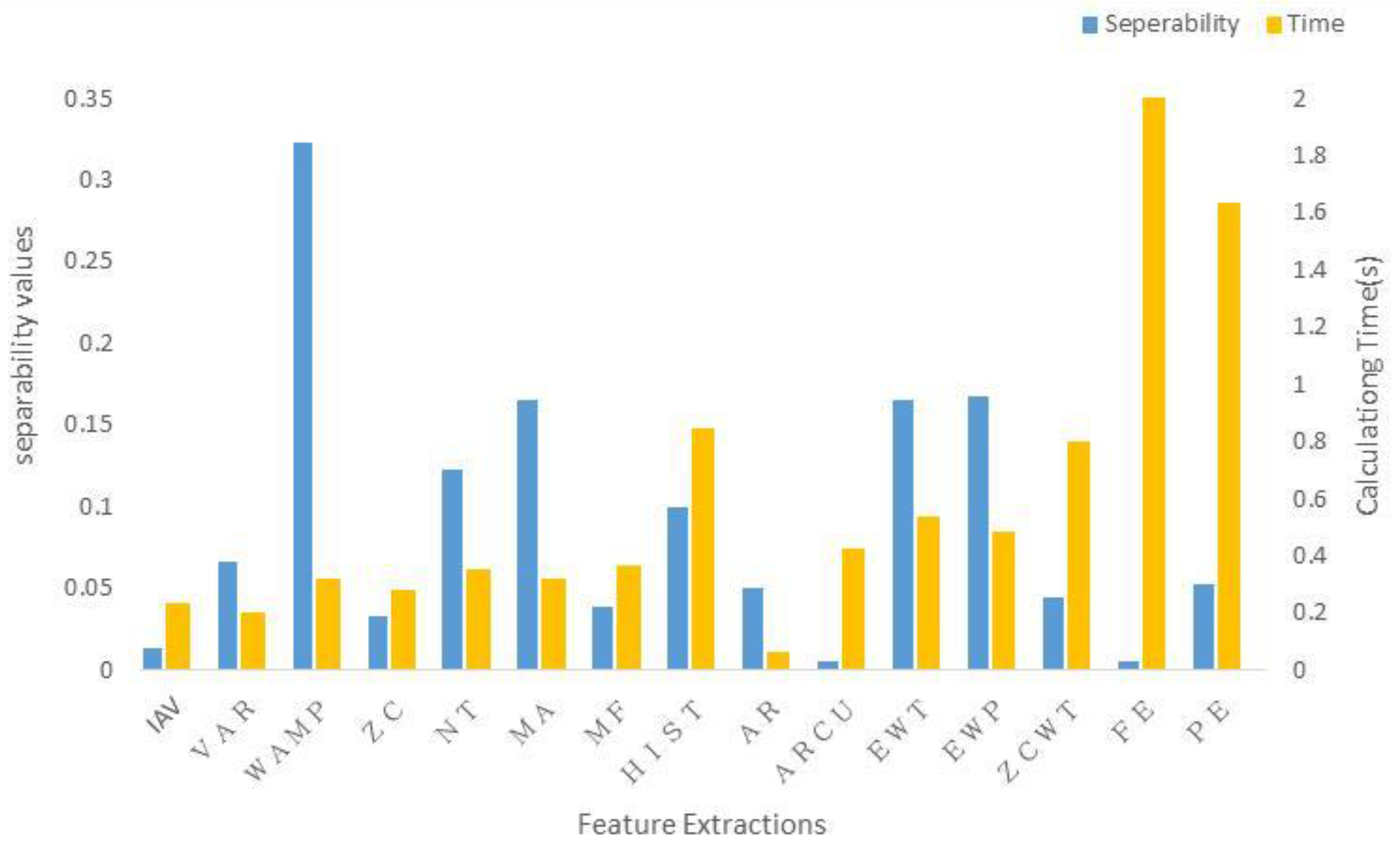
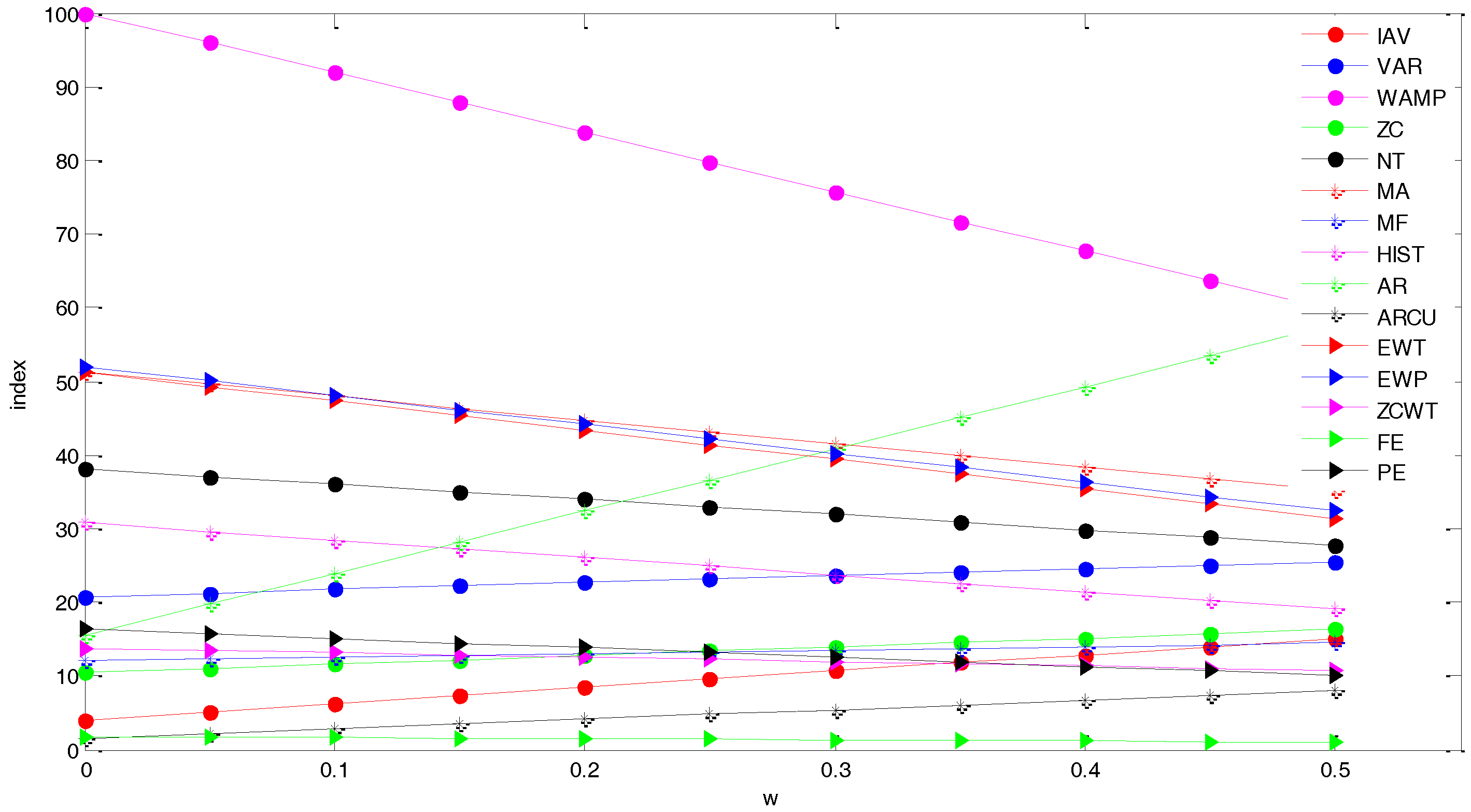
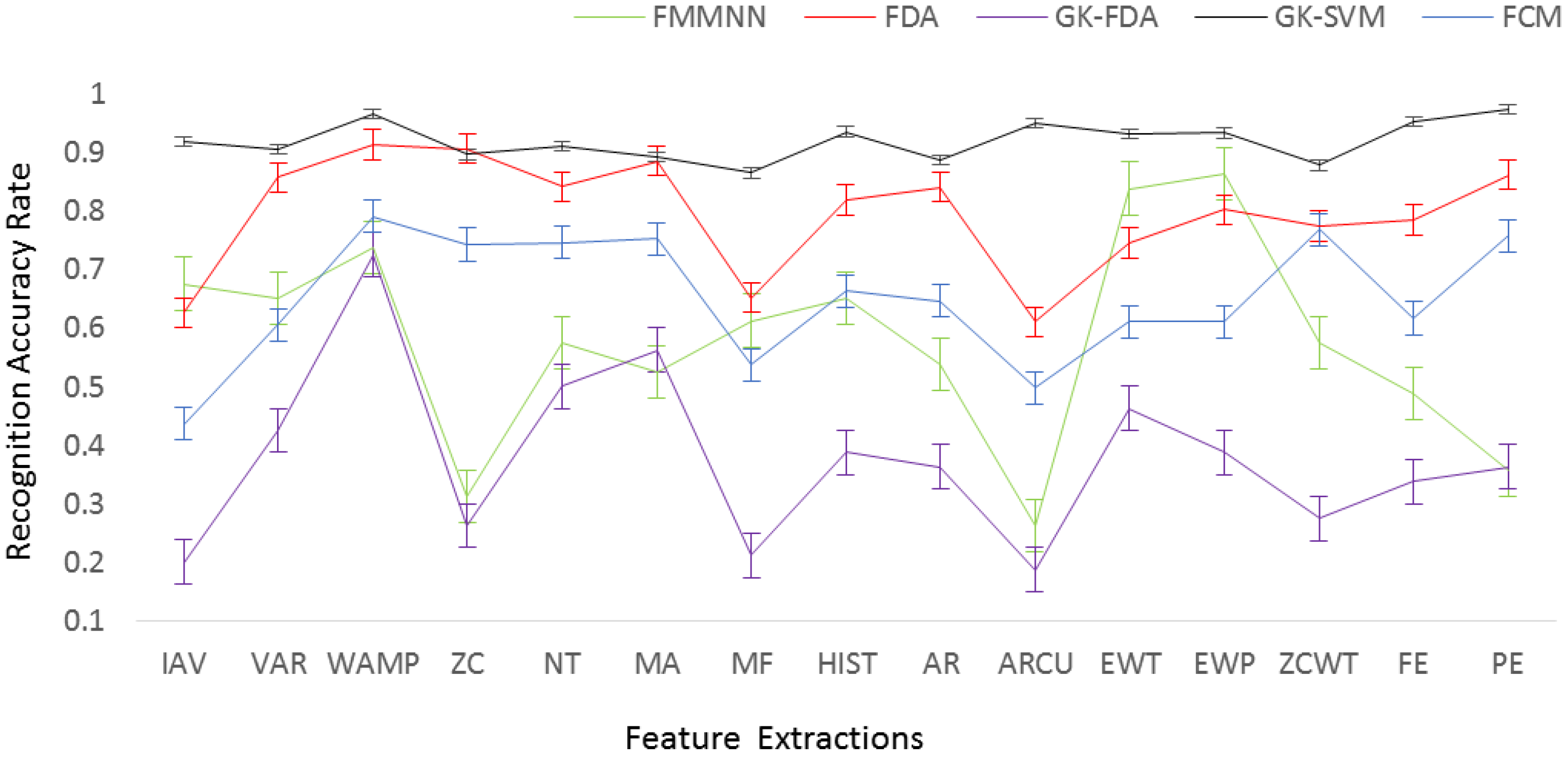
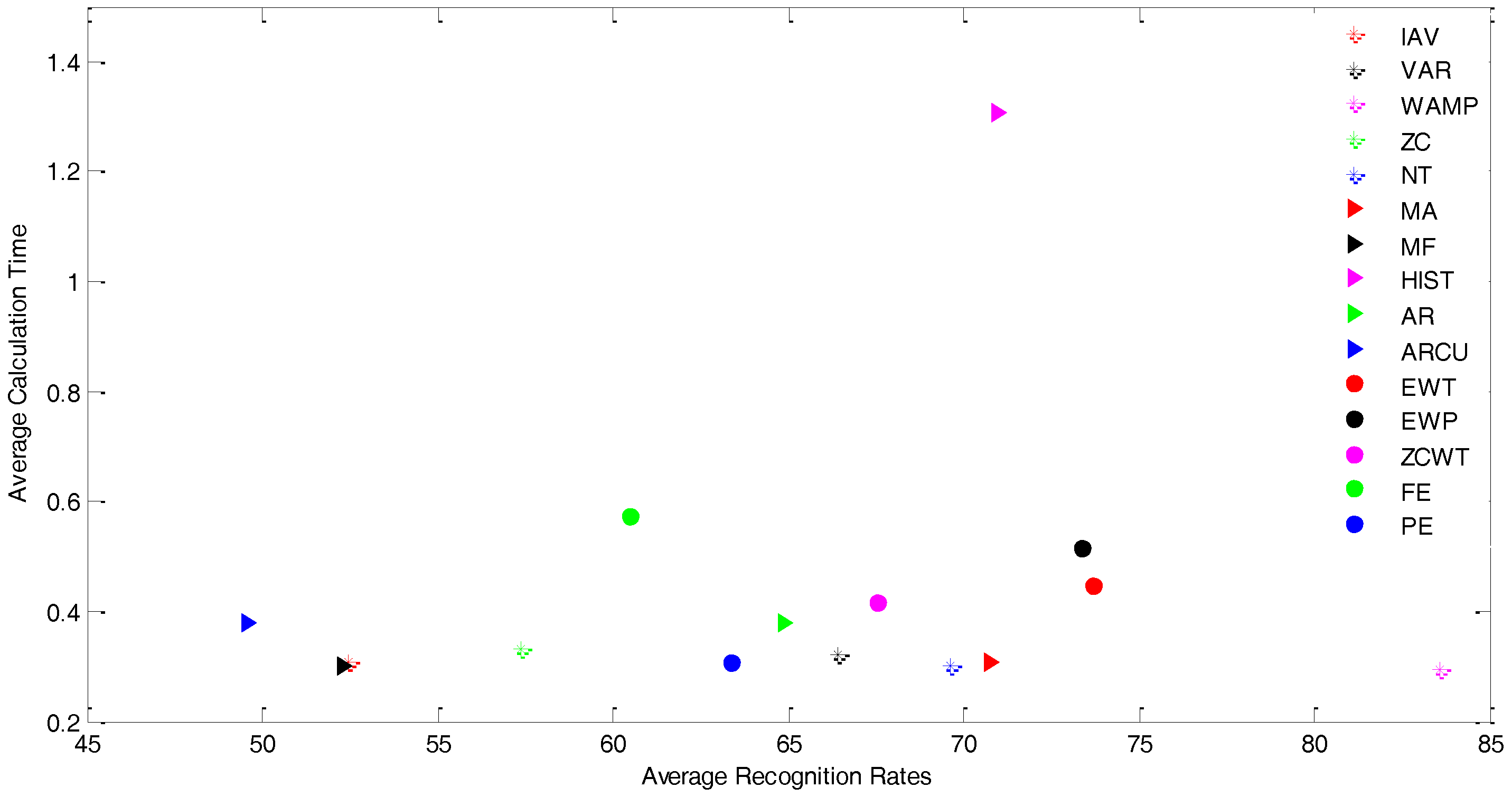
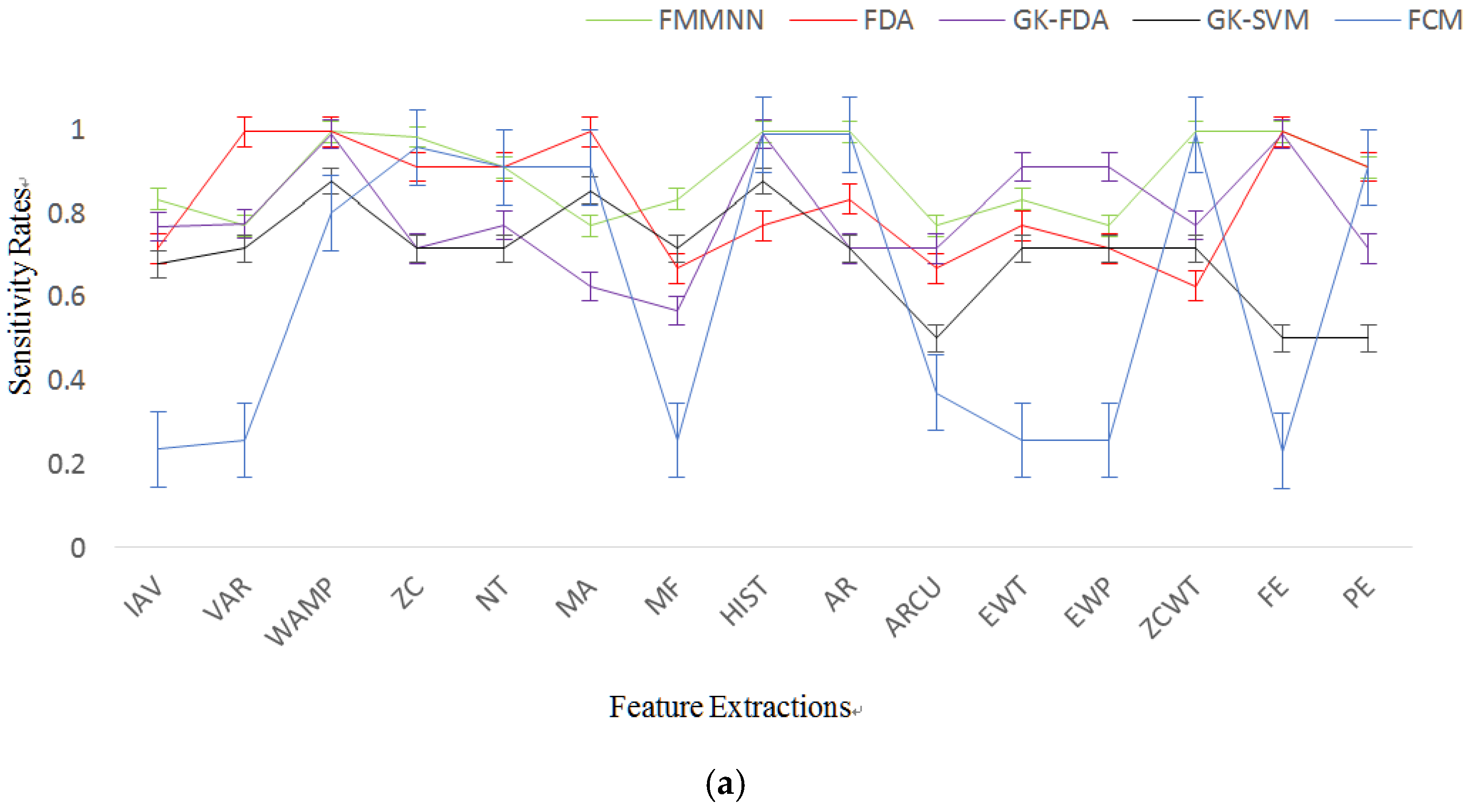


| ID | Extraction Feature | Acronym | Dimension |
|---|---|---|---|
| 1 | Integral of Absolute Value | IAV | 4 |
| 2 | Variance | VAR | 4 |
| 3 | Wilson Amplitude | WAMP | 4 |
| 4 | Zero Crossing | ZC | 4 |
| 5 | Number of Turns | NT | 4 |
| 6 | Mean of Amplitude | MA | 4 |
| 7 | Mean Frequency | MF | 4 |
| 8 | Histogram | HIST | 84 |
| 9 | Auto-Regressive Coefficient | AR | 12 |
| 10 | Auto-Regressive Coefficient From Third-Order Cumulant | ARCU | 12 |
| 11 | Energy of Wavelet Coefficient | EWT | 20 |
| 12 | Energy of Wavelet Packet Coefficient | EWP | 32 |
| 13 | Zero Crossing of Wavelet Coefficient | ZCWT | 20 |
| 14 | Fuzzy Entropy | FE | 4 |
| 15 | Permutation Entropy | PE | 4 |
| Classification Algorithm | Acronym |
|---|---|
| Fisher Discriminant Analysis | FDA |
| Fuzzy Min-Max Neural Network | FMMNN |
| Kernel Linear Discriminant Analysis | GK-FDA |
| Kernel Support Vector Machine | GK-SVM |
| Fuzzy C-Means | FCM |
| FMMNN | FDA | GK-FDA | GK-SVM | FCM | |
|---|---|---|---|---|---|
| IAV | 67.50 800.94 | 62.60  | 20.00 77.563 | 91.73 49.61 | 43.59 402.28 |
| VAR | 65.00 789.70 | 85.66 284.16 | 42.50 59.978 | 90.41 40.54 | 60.47 427.47 |
| WAMP | 73.75 771.37 | 91.24 210.39 | 72.50 65.17 | 96.43 46.36 | 79.06 356.37 |
| ZC | 31.25 865.25 | 90.60 266.96 | 26.25 64.248 | 89.59  | 74.22 409.71 |
| NT | 57.50 867.31 | 84.10 197.22 | 50.00  | 91.02 48.58 | 74.53 309.41 |
| MA | 52.50 807.75 | 88.42 301.44 | 56.25 66.18 | 89.18 39.04 | 75.23 297.96 |
| MF | 61.25 796.68 | 65.10 218.02 | 21.25 70.932 | 86.43 49.71 | 53.75 356.09 |
| HIST | 65.00 4654.2 | 81.80 881.89 | 38.75 78.112 | 93.47 47.23 | 66.33 825.38 |
| AR | 53.75 1204.1 | 83.96 285.61 | 36.25 71.317 | 88.60 49.21 | 64.61 282.48 |
| ARCU | 26.25 1177.9 | 61.05 256.22 | 18.75 57.929 | 95.00 49.28 | 49.77 322.36 |
| EWT | 83.75 1322.6 | 74.49 336.01 | 46.25 64.091 | 93.06 45.35 | 61.09 417.13 |
| EWP | 86.25 1671.0 | 80.17 336.97 | 38.75 58.699 | 93.27 43.54 | 61.02 430.19 |
| ZCWT | 57.50 1236.7 | 77.36 281.92 | 27.50 57.94 | 87.76 39.83 | 76.80 398.21 |
| FE | 48.75  | 78.42 214.81 | 33.75 76.945 | 95.20 56.50 | 61.64 261.77 |
| PE | 35.75 793.57 | 86.11 278.59 | 36.25 70.546 | 97.35 50.31 | 75.70  |
| FMMNN | FDA | GK-FDA | GK-SVM | FCM | |
|---|---|---|---|---|---|
| IAV | 83.33 95.89 798.171 | 71.43 85.37 22.238 | 76.60 95.60 71.658 | 67.70 97.70 31.680 | 23.53 99.80 80.084 |
| VAR | 76.92 74.60 774.504 | 99.35 82.35  | 77.40 97.22 67.319 | 71.43 96.50 26.893 | 25.64 97.22 63.271 |
| WAMP | 99.35 99.70 914.863 | 99.35 82.35 21.554 | 98.70 98.59 65.586 | 87.50 99.80 28.058 | 80.00 99.80 66.866 |
| ZC | 98.10 98.59 985.637 | 90.91 77.78 23.987 | 71.43 97.22  | 71.43 97.22 29.470 | 95.60 80.46  |
| NT | 90.91 99.70 782.313 | 90.91 77.78 24.333 | 76.92 97.00 82.546 | 71.43 98.80 30.584 | 90.91 93.33 68.891 |
| MA | 76.92 97.22  | 99.35 84.34 24.583 | 62.50 95.60 72.768 | 71.43 99.8 26.443 | 90.91 57.38 76.955 |
| MF | 83.33 95.89 785.180 | 66.67 87.50 22.957 | 56.60 95.60 86.225 | 71.43 98.59 31.620 | 25.64 99.80 65.238 |
| HIST | 99.35 99.70 1768.134 | 76.92 59.83 36.520 | 98.70 98.59 82.650 | 71.43 99.8 35.755 | 98.70 99.80 106.047 |
| AR | 99.35 99.70 871.808 | 83.33 79.55 22.326 | 71.43 98.59 84.999 | 71.43 98.59  | 98.70 97.80 68.527 |
| ARCU | 76.92 98.59 916.730 | 66.67 68.68 29.769 | 71.43 98.59 67.665 | 50.00 95.60 38.354 | 37.04 97.22 66.568 |
| EWT | 83.33 97.22 1089.698 | 76.92 69.31 32.745 | 90.91 98.59 95.472 | 71.43 97.70 34.491 | 25.64 97.22 70.804 |
| EWP | 76.92 98.59 1343.922 | 71.43 65.42 32.826 | 90.91 95.60 88.787 | 71.43 99.80 38.128 | 25.64 97.22 121.709 |
| ZCWT | 99.35 99.70 1010.854 | 62.50 89.74 45.618 | 76.92 97.90 81.515 | 71.43 96.50 45.383 | 98.7 82.35 73.311 |
| FE | 99.35 99.70 747.180 | 99.35 72.92 398.935 | 98.70 98.59 437.390 | 50.00 98.59 398.873 | 22.99 99.80 432.002 |
| PE | 90.91 98.50 820.835 | 90.91 78.65 46.068 | 71.43 97.22 86.390 | 50.00 98.59 50.373 | 90.91 69.31 86.616 |
© 2017 by the authors. Licensee MDPI, Basel, Switzerland. This article is an open access article distributed under the terms and conditions of the Creative Commons Attribution (CC BY) license (http://creativecommons.org/licenses/by/4.0/).
Share and Cite
Xi, X.; Tang, M.; Miran, S.M.; Luo, Z. Evaluation of Feature Extraction and Recognition for Activity Monitoring and Fall Detection Based on Wearable sEMG Sensors. Sensors 2017, 17, 1229. https://doi.org/10.3390/s17061229
Xi X, Tang M, Miran SM, Luo Z. Evaluation of Feature Extraction and Recognition for Activity Monitoring and Fall Detection Based on Wearable sEMG Sensors. Sensors. 2017; 17(6):1229. https://doi.org/10.3390/s17061229
Chicago/Turabian StyleXi, Xugang, Minyan Tang, Seyed M. Miran, and Zhizeng Luo. 2017. "Evaluation of Feature Extraction and Recognition for Activity Monitoring and Fall Detection Based on Wearable sEMG Sensors" Sensors 17, no. 6: 1229. https://doi.org/10.3390/s17061229






